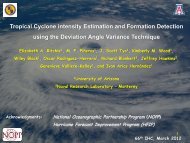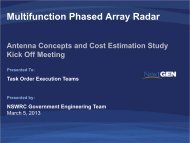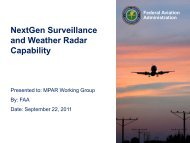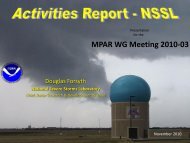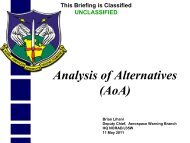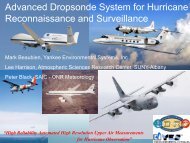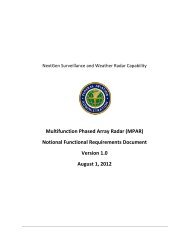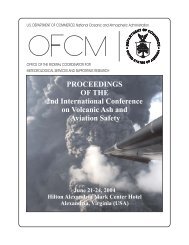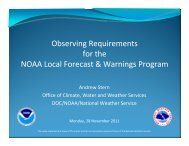Multifunction Phased Array Radar (MPAR) Automatic Dependent ...
Multifunction Phased Array Radar (MPAR) Automatic Dependent ...
Multifunction Phased Array Radar (MPAR) Automatic Dependent ...
You also want an ePaper? Increase the reach of your titles
YUMPU automatically turns print PDFs into web optimized ePapers that Google loves.
”<strong>Multifunction</strong> <strong>Phased</strong> <strong>Array</strong> <strong>Radar</strong> (<strong>MPAR</strong>) <strong>Automatic</strong> <strong>Dependent</strong><br />
Surveillance – Broadcast (ADS-B) Backup Requirements”<br />
Study Synopsis<br />
Steven D. Campbell<br />
MIT Lincoln Laboratory<br />
9 March 2009<br />
This report provides a synopsis of a study that was carried out for the Federal Aviation<br />
Administration by MIT Lincoln Laboratory to examine the ability of the <strong>Multifunction</strong><br />
<strong>Phased</strong> <strong>Array</strong> <strong>Radar</strong> (<strong>MPAR</strong>) to serve as a backup to <strong>Automatic</strong> <strong>Dependent</strong> Surveillance<br />
– Broadcast (ADS-B).<br />
Introduction<br />
In 2005, the Federal Aviation Administration asked Lincoln Laboratory to evaluate<br />
technology issues, operational considerations and cost-trades associated with the concept<br />
of replacing current national air traffic and weather surveillance radars with a single<br />
network of multifunction phased array radar. Based on this request, Lincoln Laboratory<br />
described a conceptual <strong>MPAR</strong> high-level system design, and carried out initial<br />
development and testing of critical subsystems. This work has suggested that <strong>MPAR</strong>s can<br />
be cost-effective replacements for existing, mechanically scanned operational air traffic<br />
and weather surveillance radars [1, 2, 3].<br />
The FAA’s air traffic control surveillance architecture for the future is based on the<br />
application of <strong>Automatic</strong> <strong>Dependent</strong> Surveillance via Broadcast (ADS-B) technology.<br />
However, in order to have a robust ATC system, provisions must be made to deal with<br />
failure modes of ADS-B (e.g., malfunction of the ADS-B avionics in a given aircraft, loss<br />
of GPS capability, etc.). The FAA’s ADS-B backup strategy study concluded that<br />
current primary surveillance radar networks should be maintained to guard against single<br />
aircraft avionics loss, and that roughly half of today’s secondary radars should be retained<br />
to allow for continued full-capability ATC services in the event of a loss of GPS signal.<br />
The study addressed the use of <strong>MPAR</strong>s for ADS-B backup. The approach employed was<br />
to first identify the required aircraft and weather surveillance goals, and then examine<br />
various alternative networks for achieving this surveillance performance. Design<br />
tradeoffs were examined to determine the required power and number of phased-array<br />
elements for the en route and terminal <strong>MPAR</strong>s, and scan strategies were developed meet<br />
the performance goals. It was found that designs could be devised with provide<br />
comparable accuracy to ADS-B for aircraft surveillance, and much better update rate and<br />
volume coverage for weather surveillance.<br />
1
Surveillance Goals<br />
The required surveillance performance for ADS-B is shown in Table 1 [4]. The position<br />
accuracy is shown as a function of Navigation Accuracy Category – Position (NAC P ),<br />
and the update interval is shown as a function of airspace.<br />
Table 1. ADS-B Required Surveillance Performance<br />
Parameter Airspace Value<br />
Position Accuracy All<br />
35-100’ (95%) NACp = 9*<br />
100-300’ (95%) NACp = 8<br />
300-600’ (95%) NACp = 7<br />
Update Interval<br />
Terminal<br />
High Rate En Route<br />
3 sec (95%)<br />
En Route 6 sec (95%)<br />
*NAC P = Navigation Accuracy Category (position).<br />
Figure 1 shows the required <strong>MPAR</strong> azimuthal resolution vs range as a function of NAC P ,<br />
assuming a 20:1 cross-range resolution improvement with monopulse processing. It can<br />
be seen that for NAC P = 7, a 1° beam can satisfy the aircraft surveillance requirement out<br />
to nearly 120 nm range, and a 2° beam can satisfy the requirement out to nearly 60 nm<br />
range.<br />
Figure 1. <strong>MPAR</strong> Azimuthal Resolution vs Range (20:1 monopulse)<br />
2
Given the above considerations, the aircraft and weather surveillance goals that were<br />
established for en route and terminal <strong>MPAR</strong> are shown in Table 2. These goals improve<br />
aircraft surveillance to be comparable with ADS-B, and maintain or improve weather<br />
surveillance.<br />
Table 2. <strong>MPAR</strong> Aircraft and Weather Surveillance Goals.<br />
Angular<br />
Coverage<br />
Resolution Update<br />
Sensitivity<br />
Rate<br />
Range Altitude Az El<br />
Terminal<br />
Surveillance<br />
En Route<br />
Surveillance<br />
Terminal<br />
Weather<br />
En Route<br />
Weather<br />
1 m 2 60 nm 20,000’ 2.0° 5.0° 3 s<br />
2.2 m 2 200 nm 60,000’ 1.0° 2.0° 6 s<br />
0 dBZ 60 nm 15,000’ 1.4° 2.0° 60 s<br />
0 dBZ 120 nm 60,000’ 1.0° 1.0° 300 s<br />
Network Configuration<br />
Having determined the <strong>MPAR</strong> performance goals, the next step was to determine the<br />
network configuration. The proposed approach is shown in Figure 2, in which there are a<br />
set of long-range (i.e., 250 nm) <strong>MPAR</strong>s to guard the CONUS border and a larger number<br />
of medium-range <strong>MPAR</strong>s to provide coverage of the interior en route airspace.<br />
Figure 2. Proposed <strong>MPAR</strong> network configuration.<br />
3
Figure 3 shows the terrain coverage at 18,000’ for the en route <strong>MPAR</strong>s for various<br />
ranges. It can be seen from the figure that 120 nm spacing is adequate for en route<br />
surveillance, and requires a modest number of 155 sensors.<br />
Figure 3. En Route <strong>MPAR</strong> terrain coverage at 18,000’ for different ranges.<br />
<strong>Phased</strong>-<strong>Array</strong> Elements<br />
The next consideration in the study was the power per phased-array element and the total<br />
number of elements required. Figure 4 shows the aircraft surveillance range vs power per<br />
element for en route and terminal <strong>MPAR</strong>s for various beam widths. It can be seen from<br />
the figure that 2 W per element for En Route <strong>MPAR</strong> surveillance (1° beam, 120 nm<br />
range) and 5 W per element for Terminal <strong>MPAR</strong> surveillance (2° beam, 60 nm range)<br />
meet the design requirements.<br />
Figure 5 shows an example of one possible tradeoff between element power and weather<br />
sensitivity. In this example, the minimum detectable weather signal in dBZ is shown vs<br />
range for NEXRAD, en route <strong>MPAR</strong>, TDWR and terminal <strong>MPAR</strong>. In the case of the<br />
<strong>MPAR</strong> designs, it is necessary to employ short uncompressed pulses at short range to get<br />
the necessary range resolution and longer compressed pulses at longer ranges to get the<br />
necessary sensitivity. The transition between uncompressed and compressed pulses<br />
occurs at the discontinuity in minimum detectable signal in each case. For this example,<br />
the en route <strong>MPAR</strong> requires 2.5 W per element for a 1° beam and the terminal <strong>MPAR</strong><br />
requires 10 W per element for a 2° beam. These beam widths correspond to 20,000<br />
elements per face for en route <strong>MPAR</strong> and 5,000 elements per face for terminal <strong>MPAR</strong>.<br />
4
Figure 4. Aircraft surveillance range vs power per element.<br />
Figure 5. Example of weather sensitivity tradeoff.<br />
5
<strong>MPAR</strong> Scan Designs<br />
The final study task was to design scan strategies for en route and terminal <strong>MPAR</strong>s. Of<br />
the two cases, the terminal <strong>MPAR</strong> scan strategy is the more challenging because of the<br />
need to check for wind shear hazards such as microbursts every 60 seconds. The<br />
approach that was adopted is illustrated in Figure 6. In the case of terminal <strong>MPAR</strong>, it is<br />
necessary to carry out aircraft surveillance every 4.8 seconds in order to be comparable to<br />
existing airport surveillance radars.<br />
However, it is possible to carry out the necessary aircraft surveillance in roughly 2.9<br />
seconds by employing a multiple-beam design developed at Lincoln Laboratory. This<br />
leaves the remainder of the 4.8 seconds available to carry out portions of the weather<br />
scans, including a horizon scan for wind shear hazards every 60 seconds and a 3-D<br />
weather volume scan for storms every 72 seconds. Although this scan strategy does not<br />
meet the 3 second terminal aircraft surveillance update rate, it is likely that reducing the<br />
PRI (Pulse Repetition Interval) and number of pulses for higher elevation scans would<br />
likely meet this goal.<br />
A similar analysis was applied to the en route <strong>MPAR</strong> scan design. In this case, the 6<br />
second aircraft surveillance goal is met, and the horizon and 3-D weather update rates are<br />
120 seconds. This represents a significant improvement over existing en route weather<br />
scans. Another advantage for both the en route and terminal <strong>MPAR</strong> weather scans is<br />
that the beams are contiguous in the vertical dimension, whereas the NEXRAD and<br />
TDWR vertical beams are not contiguous and relatively widely spaced.<br />
Figure 6. <strong>MPAR</strong> scan designs.<br />
6
Conclusions<br />
This study examined the feasibility of using multifunction phased-array radars as a<br />
backup for ADS-B. It was found that a network consisting of approximately 30 longrange<br />
(240 nm) <strong>MPAR</strong>S or existing ASRR-4s for border protection, 155 medium-range<br />
(1° beam, 120 nm) en route <strong>MPAR</strong>s and 200 short-range (2° beam, 60 nm) terminal<br />
<strong>MPAR</strong>s would provide the necessary coverage for CONUS.<br />
The accuracy of the <strong>MPAR</strong>s would be comparable to ADS-B (for NAC P = 7) for aircraft<br />
surveillance, and that the weather surveillance would be much superior to existing<br />
weather radars by offering both higher update rate and contiguous beams.<br />
Scan strategies were also devised for both the en route and terminal <strong>MPAR</strong>s. The<br />
terminal strategy meets the existing aircraft update rate of 4.8 seconds but could likely<br />
meet the 3 second terminal ADS-B update rate with reduced PRI and pulses aloft. The en<br />
route strategy meets the 6 second ADS-B aircraft update rate with 120 second 3-D<br />
weather updates.<br />
The recommended <strong>MPAR</strong> radar characteristics for the en route <strong>MPAR</strong> is 20,000<br />
elements per face yielding a 1° beam, and 2.5 W per element for 120 nm aircraft and<br />
weather surveillance range. This design yields good performance for both aircraft and<br />
weather surveillance. The recommended terminal <strong>MPAR</strong> configuration is 5,000 elements<br />
for a 2° beam, and 10 W per element for 60 nm aircraft and weather surveillance range.<br />
This design yields good aircraft surveillance accuracy and acceptable weather resolution.<br />
7
References<br />
[1] Weber, M.E. et al, “Multi-purpose <strong>Phased</strong> <strong>Array</strong> <strong>Radar</strong> For U.S. Civil-Sector<br />
Surveillance Needs”, 32nd Conf. on <strong>Radar</strong> Meteorology, Albuquerque, NM, Amer.<br />
Meteor. Soc., 2005.<br />
[2] Weber, M.E et al, “<strong>Multifunction</strong> <strong>Phased</strong> <strong>Array</strong> <strong>Radar</strong>: Technical Synopsis, Cost<br />
Implications and Operational Capabilities”, 23 rd Conf. on Interactive Information and<br />
Processing Systems for Meteorology, Oceanography, and Hydrology, San Antonio,<br />
TX, Amer. Meteor. Soc., 2007.<br />
[3] Herd, J.S. et al, “Preliminary <strong>Multifunction</strong> <strong>Phased</strong> <strong>Array</strong> <strong>Radar</strong> (<strong>MPAR</strong>)<br />
Preprototype Development”, 23 rd Conf. on Interactive Information Processing<br />
Systems for Meteorology, Oceanography, and Hydrology, San Antonio, TX, Amer.<br />
Meteor. Soc., 2007.<br />
[4] “<strong>Automatic</strong> <strong>Dependent</strong> Surveillance – Broadcast (ADS-B) Out Performance<br />
Requirements to Support Air Traffic Control (ATC) Service”, Docket No. FAA-<br />
2007-29305, Notice No. 07-15, October 2, 2007.<br />
8



